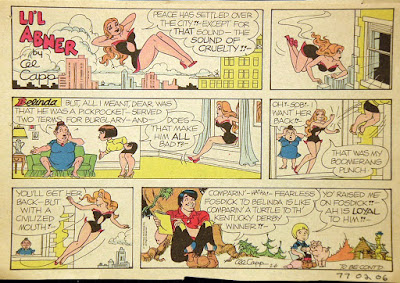Four Color
Pages
Pages
Tuesday, 30 March 2021
Four Color Dell 1942 -1962 [#1101-#1125]
Sunday, 28 March 2021
Li’l Abner (1934 - 1977) - Al Capp [Daily Comic Strip]
Li’l Abner also featured a comic strip-within-the-strip: Fearless Fosdick was a parody of Chester Gould’s plainclothes detective, Dick Tracy. It first appeared in 1942, and proved so popular that it ran intermittently in Li’l Abner over the next 35 years. Gould was also personally parodied in the series as cartoonist Lester Gooch— the diminutive, much-harassed and occasionally deranged “creator” of Fearless Fosdick.
Fosdick’s duty, as he sees it, is not so much to maintain safety as to destroy crime, and it’s too much to ask any law-enforcement officer to do both, I suppose.” Fosdick lived in squalor at the dilapidated boarding house run by his mercenary landlady, Mrs. Flintnose. He never married his own long-suffering fiancée Prudence (ugh!) Pimpleton (they’ve been engaged for 17 years), but Fosdick was directly responsible for the unwitting marriage of his biggest fan, Li’l Abner to Daisy Mae in 1952. The bumbling detective became the star of his own NBC-TV puppet show that same year. Fosdick also achieved considerable exposure as the long-running advertising spokesman for Wildroot Cream-Oil, a popular men’s hair product of the postwar period.
https://en.wikipedia.org/wiki/Li%27l_Abner
https://www.dailycartoonist.com/index.php/2018/10/28/first-and-last-lil-abner/
https://newspapercomicstripsblog.wordpress.com
https://peanuts.fandom.com/wiki/Li%27l_Abner
Li’l Abner
Years 1934 - 1977
Daily Comic Strip
Link👇👇
Thursday, 25 March 2021
Brick Bradford [D001-D027] - Daily strips by Clarence Gray and William Ritt
Daily strips by Clarence Gray and William Ritt
- D001 In the City Beneath the Sea (08/21/1933 – 06/30/1934) 270 strips
- D002 With Brocco the Buccaneer (07/02/1934 – 05/18/1935) 276 strips
- D003 On the Isles Beyond the Ice (05/20/1935 – 04/11/1936) 282 strips
- D004 Brick Bradford and the Lord of Doom (04/13/1936 – 02/06/1937) 258 strips
- D005 Adrift in an Atom [aka Voyage in a Coin] (02/08/1937 – 01/08/1938) 288 strips
- D006 In the Fortress of Fear (01/10/1938 – 02/11/1939) 342 strips
- D007 Brick Bradford and the Metal Monster (02/13/1939 – 03/16/1940) 342 strips
- D008 Brick Bradford Seeks the Diamond Doll (03/18/1940 – 12/28/1940) 246 strips
- D009 On the Throne of Titania (12/30/1940 – 06/12/1943) 768 strips
- D010 Beyond the Crystal Door (06/14/1943 – 10/21/1944) 462 strips
- D011 The Queen of the Night (10/28/1944 – 06/01/1946) 468 strips
- D012 The Witch Doctor of Wanchi (06/03/1946 – 12/07/1946) 162 strips
- D013 The Strange Case of Captain Boldd (12/09/1946 – 07/19/1947) 192 strips
- D014 Lost Train In Tunnel #10 (07/21/1947 – 05/01/1948) 246 strips
- D015 The Prophet of Thorn (05/03/1948 – 03/19/1949) 276 strips
- D016 The Colossal Fossil (03/21/1949 – 07/02/1949) 90 strips
- D017 The Island of the Eye (07/04/1949 – 12/24/1949) 150 strips
- D018 Smokeballs (12/26/1949 – 03/25/1950) 60 strips
- D019 The Howling Face (03/27/1950 – 06/17/1950) 90 strips
- D020 The Legacy of Low Lake (06/19/1950 – 10/07/1950) 96 strips
- D021 Detour of Doubt (10/09/1950 – 12/30/1950) 60 strips
- D022 Frame-Up (01/01/1951 – 03/31/1951) 90 strips
- D023 Mesa Macabre (04/02/1951 – 08/11/1951) 114 strips
- D024 Moon Maiden (08/13/1951 – 10/06/1951) 48 strips
- D025 Shadow in the Sky (10/08/1951 – 02/16/1952) 102 strips
- D026 The Six Seeds of Sibed (02/18/1952 – 05/10/1952) 96 strips
- D027 Mr. Distance (05/12/1952 – 10/18/1952) 138 strips





















































